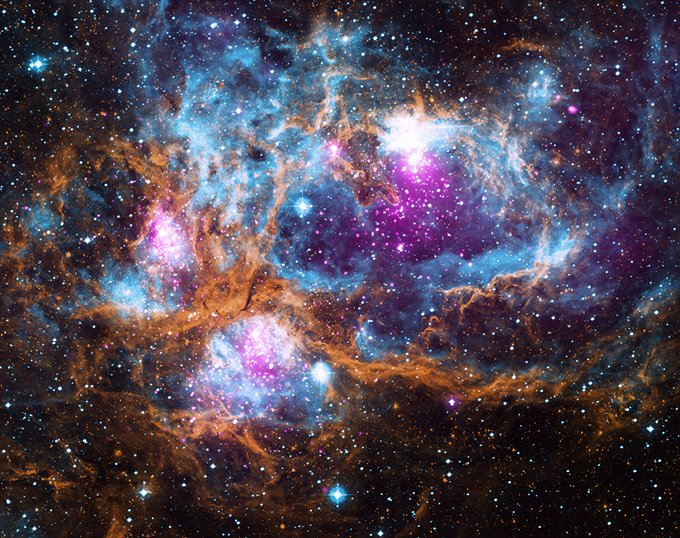This colorful image depicts a region called NGC 6357, located in our own galaxy about 5,500 light years from Earth. It contains many young, energized stars surrounded by cooler gas clouds. This festive cosmic photography wasn’t just created by some holiday spirit; it required a lot of teamwork from advanced space equipment.
Infrared data contributes the sweeping orange color, captured by NASA’s Spitzer Space Telescope. This particular telescope is the last mission of NASA’s Great Observatories Program – a series of four powerful astronomical telescopes that examine the universe at different wavelengths. The Cryogenic Telescope Assembly houses the 85-cm telescope and specialized components including an infrared array camera (IRAC), infrared spectrograph (IRS), and multiband imaging photometer (MIPS).
The rich purple hues showcase the collected X-ray data from the ROSAT telescope and NASA’s Chandra X-ray Observatory. The Chandra X-ray Observatory joins the Spitzer Space Telescope in the fleet of “Great Observatories” instruments. Since the Earth’s atmosphere absorbs X-rays, the Chandra Observatory has to orbit at an altitude of 86,500 miles (139,000 km) in space. A few of Chandra’s high-tech space instruments include a high-resolution camera (HRC), advanced CCD imaging spectrometer (ACIS), and both a high- and low-energy transmission grating spectrometer (HEGTS, LEGTS).
Finally, the ethereal blue hues represent the optical data collected from the SuperCosmos Sky Survey. The SuperCosmos is defined as “an advanced photographic plate digitizing machine.” It uses information gathered from the UK Schmidt, Palomar Schmidt, and ESO Schmidt telescopes.
Feel free to examine the beautiful final image below!

(Image Credit: X-ray: NASA/CXC/PSU/L. Townsley et al; Optical: UKIRT; Infrared: NASA/JPL-Caltech)
Filed Under: Aerospace + defense




